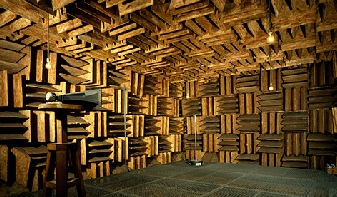






Ultrasound and Echoes
Go to a mountain area and yell, you’ll here your voice. Even going through a tunnel you’ll here your echo. There’s really only a few places in the world where it is really quite.
In Minneapolis there is a room, where 99% of the sound is cancelled out.
It’s so quite in the room that some people have reported being able to hear their blood flow through their ears

In this room, no echo is made. An echo is made when a sound reflects off a surface.
Since sound travels slowly, there is a time delay between making a sound and hearing the echo.
Using an echo, you can calculate the distance from your self to an object.
We know that sound travels 340m/s in the air. So if we here an echo 1 second after we clap, the object it is bouncing off must be 170 m away.
170m to get to the wall, and 170 m to get back to you.

If it took 5 seconds to hear your echo, that means the total distance the sound traveled was (5x340) 1700m.
This means the object is 850m away from you.
Now, imagine if your in a concert hall. All those instruments and voices,making echoes could eventually become a nuisance.
When lots of echoes join together they create a reverberation.
Soft materials like carpet make great sound absorbers, since they don’t reflect sound like wood.
You’ve probably heard of ultrasound, but not echolocation. Unlike ultrasound, echolocation helps animals locate objects using sounds at frequencies we can hear.
Ultrasound is different to echolocation, in that the frequency is much higher. Above 20,000 Hz.
Bats use Ultrasound to locate their prey
Doctors use ultrasound when looking into the body. We use frequencies of above 20,000 Hz to see into the womb of a foetus.
We can also use Ultrasound to see any heart problems, cancer issues, liver damage, Break down kidney stones and even measuring the speed of blood flow in the body.
When using ultrasounds on animals, the sound waves travel through the skin and bounce (reflect) off the organ/foetus.
If we concentrate the sounds on a specific area, we can use the vibrations to break apart tiny stones which may be lodged in the kidneys.
Ships, dolphins, whales and other marine animals will use sonar to locate objects and animals.
In ships a transmitter will send out a beam of ultra sound. The sound is reflected by the ground/animal/object and a receiver picks up the reflected wave.
Questions
Short Answer Questions
1. Define the term Ultrasound
2. Explain how bats use ultrasound to hunt pray? Why do they use ultrasound instead of echolocation?
3. What is an echo?
4. Describe two ways that a doctor might use ultrasound?
5. Define the term frequency
6. Copy and complete the sentence:
An echo is a ______ of sound. You can use the ______ between making a sound and hearing an echo from a surface to calculate the __________ to it. Soft materials ________ sound and reduce echoes. Animals use ultrasound to ___________ and __________ . Ultrasound is used to make an _______ of a fetus, or break down __________ . Fisherman can use ultrasound to find the _________ of the ocean.
7. Sound travels at 1500 m/s in liquid. If you where on a fishing boat and sent out a signal. Work out the distance of the object if the sound took (x) amount of time to return. (Show you working out)
a. 1
b. 3
c. 6
d. 10
e. 14
Extension
8. Explain in detail how sonar works. Draw and label a diagram to help your explanation. (6 marks)




